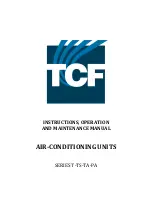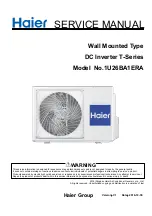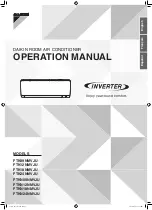
Manual 2100-597G
Page
46 of 68
FIGURE 27
Control Board Configuration/Setting
CONFIGURING BARD PART #8403-067
CO
2
CONTROL for CRV MODULATING
CONTROL
Bard part #8403-067
C
arbon dioxide and temperature
transmitters accurately monitor the CO
2
concentration
and temperature in schools, office buildings and
other indoor environments to help achieve LEED®
certification.
Specifications
Range:
CO
2
: 0 to 2000 or 0 to 5000 ppm (depending
on model)
Temperature: 32 to 122°F (0 to 50°C)
Accuracy:
±40 ppm + 3% of reading
Temperature Dependence:
±8 ppm/°C at 1100 ppm
Non-Linearity:
16 ppm
Pressure Dependence:
0.13% of reading per mm of Hg
Response Time:
2 minutes for 99% step change
Ambient Operating Temperature:
32 to 122°F (0 to 50°C)
Ambient Operating Humidity:
10 to 95% RH
(non-condensing)
Power Requirements:
16 to 35 VDC/19 to 28 VAC
Power Consumption:
Average: 2 watts;
Peak: 3.75 watts
Move jumper pin to “P”
position to allow variable
ventilation control using 0-10
VDC CO
2
controller
Board mode pins factory
shipped on “M” pin for On/Off
control scheme using “A” signal
on low voltage control board
“Red” status light (on
when unit has power)
“Green” signal light continuously
indicates the flow index the
blower is producing. After a
pause, the lamp will flash out
long digits which will indicate
the “TENS” count, which is
immediately followed by short
flashes between 1 and 99. For
example, a flow index of 23 would
yield two long flashes and three
short flashes.
Manual adjust screw. Use when operating in manual mode (“M”
jumper installed) along with the “GREEN SIGNAL LIGHT” to
adjust to the required CFM of ventilation. CW rotation reduces the
“FLOW INDEX”, CCW rotation increases the “FLOW INDEX”.
Series 1
EVO™/ECM-ACU+
Evolution Controls Inc.
p.3 of 4.
©Evolution Controls Inc.
12
-May
-09
0.265"
ø
0.1
87
5"
Us
e #
8 F
lath
ea
d
Use
4mm
Flathead
1.133"
1.429"
36.30mm
1.793"
45.54mm
64.01mm
2.520"
28.78mm
6.73mm
21
.3
9m
m
0.
84
2"
44
.4
5m
m
1.
75
0"
RPM Out
Neutral/Common
24Vac/dc
24Vac/dc
Common
Signal Common
Control Signal
Class II Power Source
Earth neutral/Common
at transformer
for electrical safety.
Signal Common,
Aux Common &
Neutral/Common are
internally connected
Aux
Power
ECM Motor Control Cable
To Automation
Controller
0-2,000 RPM
= 0-10Vdc
Mounting
Mount the ACU+ inside a metal control cabinet or
enclosure. Fasten the mounting posts to an earthed metal
surface.
Mount the ACU+ with clearance for the 24Vac power wires,
automation wires and control cable connector. Mount the
control so the signal lamps are visible. Make Adjust
accessible if it is used in your application. The control may
be surface mounted, or reverse mounted so the LEDs and
control shaft are visible through the enclosure wall. For
surface mount, a silver or white surface under the LEDs
makes them more visible from the component side of the
ACU+. The control’s motor cable connector is small so it
may be carefully pulled through an empty 3/4” conduit.
Keep high voltage wiring away from the ACU+ circuitry or
wiring. Follow electrical code requirements for separation of
high and low voltage wiring and components.
Wiring
Power the EVO/ECM-ACU+ with a 24Vac NEC Class II
USA
power limited transformer
3
. Observe all code requirements
and follow all safety practices regarding low voltage power supplies and circuits to insure a safe, reliable installation.
Some applications may require an isolated power supply or alternative earthing scheme. Follow code requirements and
carefully observe all safety practices concerning unearthed low voltage circuits.
Earth one lead of the 24 Vac side of the power transformer
4
. Connect the ACU+ neutral connection to the earthed lead.
Connect the 24Vac 50/60Hz connection to the hot side of the 24 Vac Class II power source. With the “P” jumper out,
you may interrupt this connection as a means to stop the ECM Motor. Most automation controllers will power the
ACU+ directly from a 24 Vac on/off output, eliminating the fan relay. Automation controllers that switch neutral may
require a fan relay.
The signal input is single-ended, so power neutral and signal common are internally connected.
Connect the 0-10 Vdc control signal
to the Signal connection. Connect
the control signal common to the
Neutral connection.
The input presents a 21K ohm load
to the signal source. Include this
resistance when calculating a
dropping resistor for 4-20 Ma
operation. A 511 ohm 1% resistor
5
provides a 500 ohm dropping
resistance.
Connect to the motor using an
EVO/ECM-CBL motor control cable.
3
See NEC
USA
725.41
4
NEC
USA
250.20.a.
5
www.Mouser.com
pn. 271-511-RC
Series CDT Carbon Dioxide and Temperature Transmitters
accurately monitor
the CO2 concentration and temperature in schools, office buildings, and other
indoor environments to help achieve LEED® certification. For increased sensor
life, a single- beam dual-wavelength non-dispersive infrared (NDIR) sensor is used
to automatically correct the measurement in both occupied and unoccupied
buildings against aging effects. The single-beam dual-wavelength sensor
technology provides the highest level of accuracy compared to Automatic Baseline
Correction methods which can unintentionally shift the calibration based on CO
2
levels and barometric pressure conditions. In order to achieve a higher level of
accuracy, the Series CDT includes digital barometric pressure adjustment and the
ability to field-calibrate the sensor.
Universal outputs allow users to select the transmitter output to be 4 to 20 mA, 0
to 5 VDC or 0 to 10 VDC to work with virtually any building management controller.
An optional relay with user adjustable set points can be used to control exhaust
fans, open actuated windows or dampers, or signal a light or horn.
For applications that require visual indication, the Series CDT can be ordered with
an integral LCD display or the Model A-449 remote LCD display that can plug into
the mini-connector port on the side of the transmitter. The display can be
configured to display temperature only, CO
2
only or CO
2
and temperature together.
Push buttons are standard on the transmitters for access to the menu structure,
but the transmitter can be ordered without the buttons. To prevent tampering, the
action of the buttons can be locked out using an internal jumper selection. Menu
items that can be accessed include: engineering units, relay output set points,
display configuration, transmitter output scaling, ambient barometric pressure and
field calibration of the transmitter.
Single beam dual-wavelength sensor advantages:
• Automatically corrects for aging effects in occupied and unoccupied buildings
o
Perfect for hospitals and manufacturing plants that are occupied 24 hours per
day
• Measures actual unfiltered light intensity directly
o
Eliminates error from incorrect assumptions of gas concentration in theoretical
logic assumption methods
Series CDT Carbon Dioxide/Temperature Transmitter
Specifications - Installation and Operating Instructions
Bulletin AQ-CDT
DWYER INSTRUMENTS, INC.
phone: 219/879-8000
www.dwyer-inst.com
p.O. BOX 373 • MICHIGAN CITY, INDIANA 46361, U.S.A.
fax: 219/872-9057
e-mail: info@dwyer-inst.com
SpECIfICATIONS
Range:
CO
2
: 0 to 2000 or 0 to 5000 ppm (depending on model);
Temperature: 32 to 122°F (0 to 50°C).
Accuracy:
±40 ppm + 3% of reading.
Temperature Dependence:
±8 ppm / °C at 1100 ppm.
Non-Linearity:
16 ppm.
pressure Dependence:
0.13% of reading per mm of Hg.
Response Time:
2 minutes for 99% step change.
Ambient Operating Temperature:
32 to 122°F (0 to 50°C).
Ambient Operating Humidity:
10 to 95% RH (non-condensing).
power Requirements:
16 to 35 VDC / 19 to 28 VAC.
power Consumption:
Average: 2 watts; Peak: 3.75 watts.
Sensor:
Single beam, dual-wavelength NDIR.
Output:
Current: 4 to 20 mA (max 500 Ω);
Voltage: 0 to 5 VDC or 0 to 10 VDC (min 500 Ω);
Relay: SPST NO 2A @ 30 VDC;
RTD or thermistor per r-t curves (depending on model).
Weight:
5.6 oz (158.8 g).
4-31/64
[113.9]
3-13/32
[86.52]
35/64
[13.89]
1-13/32
[35.72]
1-53/64
[46.43]
3x 3/8
[9.53]
1-13/32
[50.01]
1-3/16
[30.20]
1-3/16
[30.20]
7/8
[22.35]
4x 3/16
[4.76]
INSTALLATION
Disconnect power supply before installation to prevent electrical
shock and equipment damage.
Make sure all connections are in accordance with the job wiring diagram and in
accordance with national and local electrical codes. Use copper conductors only.
Use electrostatic discharge precautions (e.g., use of wrist straps)
during installation and wiring to prevent equipment damage.
Avoid locations where severe shock or vibration, excessive
moisture or corrosive fumes are present.
Do not exceed ratings of this device, permanent damage not
covered by warranty may result.
Upon powering the transmitter, the firmware version will flash on
the display. A warm up period of 30 minutes is required for the
transmitter to adjust to the current CO
2
concentration.
Self calibration feature of the transmitter requires exposure to
normal outdoor equivalent carbon dioxide level once every thirty
days.
WARNING
CAUTION
CAUTION
CAUTION
NOTICE
NOTICE
Sensor:
Single beam, dual-wave length NDIR
Output:
Current: 4 to 20 mA (max 500 Ω)
Voltage: 0 to 5 VDC or 0 to 10 VDC
(min 500 Ω)
Relay: SPST NO 2A @ 30 VDC
RTD or thermistor per r-t curves
(depending on model)
Weight:
5.6 oz (158.8 g)
















































